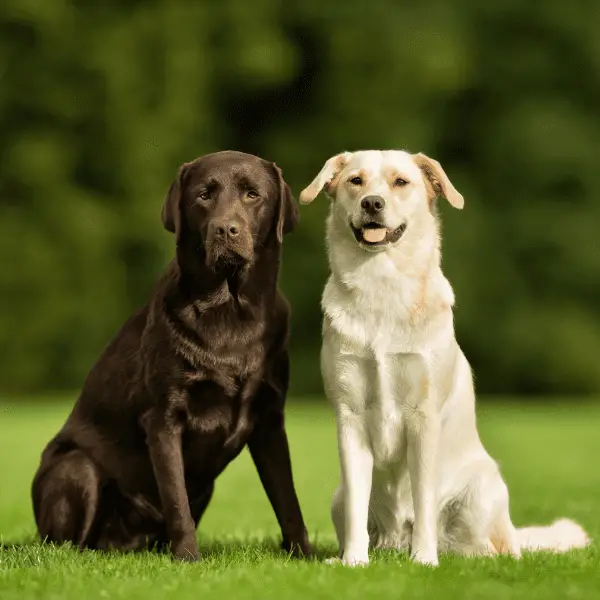The Labrador Retriever has become one of the most popular dogs worldwide. These medium-large-sized dogs are known for their affectionate and easy-going character. In most countries, Labradors are considered one of the most prevalent disability assistants. They are often trained to help people with blindness, autism or other disabilities. Due to their affectionate character, the Labradors often work as therapy dogs. The obedience and sharp intellect of the dogs have made them one of the favourites of the law enforcement departments worldwide for screening and detection works.
Origin and Lineage
The name of these dogs is a bit misleading, however. These dogs hail from Newfoundland instead of Labrador, as the name indicates. In Newfoundland, these dogs used to work as an assistant to the hunters and anglers. Labradors are used to retrieve the fishes that have gotten away and hunt down ducks.
The 1830s
The popularity of the Labrador Retriever started in the 1830s when the ships began trading between the Labrador region of Canada and the Poole in Dorsetshire. During this time, the 10th Earl of Home imported the progeny of this dog breed from Newfoundland. However, the refinement of the species had not taken place until 1880. During this time, the 3rd earl of Malmesbury, the 6th Duke of Buccleuch and the 12th Earl of Home collaborated to refine the breed.
The recorded birth of the yellow Labrador occurred in 1899. According to the description of Colonel Peter Hawker, the first Labrador was not more massive than the English Pointer. These dogs often came in black and did not carry its tail as high as the Newfoundland breed.
The Appearance of Labrador Retriever
As mentioned earlier, Labrador Retrievers are medium to large. The family males weigh between 29-36 Kg while the females weigh between 25-32 Kg.
Like some other breeds, the conformation (show, English, or Bench) and the field (Working or American) lines differ in the case of Labrador Retrievers. These two types of Labrador come from different breeding lines. However, both lines are bred in the UK and the USA.
The conformation Labradors tend to have a fuller face and calmer demeanour than their field counterpart. Labrador breeds are often taller and lighter framed dogs with longer noses.
They are saying that the field dogs are still proportional and should match the standards of the American Kennel Club. There is yet another type of labrador breed that exists in the world. Known as the Australian stock, these dogs are widespread in Asia. These dogs are good with children and are a popular choice as a family dogs.
Labradors have short, straight hair, and the tail is quite strong and broad. Thanks to their webbed toes, the Labrador Retrievers can swim excellently. In the colder climate, the webbed foot serves them as the snowshoe. The coat of the Labrador is interwoven, which helps them to become better swimmers.
Coat Colors
The coats of Labrador Retrievers officially come in three different colours, black, yellow and chocolate. Some dogs are sold as pure-bred silver Labradors. But the majority of the breed experts dispute their bloodlines. Even though some of the clubs register the silver labradors, they put them in the category of yellow.
It is common to find puppies of different colours in the same litter. Three different genes determine the colour of the pups. While these three genes determine the prominent colours of the coat, the differences in numerous other genes can be the cause of subtler details of the colouration of coats.
Temperament
The Labrador Retrievers are of kind, outgoing, pleasant and tractable nature. The strong sense of smell allows the dogs to follow almost any scent and its point of origin. Being persistent, these dogs stay on the scent until they reach their cause.
The police and military forces worldwide use Labradors as detector dogs for these characteristics. They are often employed to find the smugglers, terrorists, thieves and black marketers.
The feel of the mouth of Labrador retrievers is very delicate, as they are bred to assist in the hunting to find and retrieve the game. Even though Labradors love to chew on objects, you can manage this behaviour easily with proper training.
As these dogs are playful and good to children and other animals, Labradors are often considered the best choices for family dogs. These dogs’ fearlessness and fun-loving boisterousness have usually required firm handling. This will ensure that the adult does not become uncontrollable. Some lines of dogs mainly bred for working are very athletic and fast.
Labradors reach maturity at about three years of age. Before that, it keeps exhibiting puppy-like energy, often misinterpreted as hyperactivity. That is one of the reasons why leash training should be introduced earlier in life to ensure that a pulling situation does not occur when they are full grown.
Labradors Love To Play Fetch
The Labradors enjoy the game of retrieving balls or frisbees endlessly. Even though these dogs bark at the noise coming from unseen sources (known as alarm barking), they are not territorial or noisy. Due to their trusting behaviour toward strangers, these dogs are unsuitable guard dogs.
Labrador Retrievers are extremely curious and love the attention and the company of others. Following the scents of exciting food and people are things they love to do. With a bit of fanfare, these dogs can vanish from the owner quickly.
This makes it easier for thieves to steal the dogs. Due to their inclination toward vanishing, the rescue organisations and dog clubs think that microchipping the dogs’ collars and writing down the names and contact numbers of the owner is a great idea.
However, as they are very intelligent, they can show intense focus and single-mindedness if you motivate them properly.

Working dog
Good ethics and great temperament make the Labrador a great working dog. The typical roles that the labrador plays are tracking and detection, therapy work, carting, and disabled assistance. Almost 60-70% of all guide dogs are Labradors in Canada.
A recent study on the training of guide dogs found that Labrador Retrievers have the highest chance of completing it. The training period for Labrador retrievers to become guide dogs is less. According to the trainers, Labradors’ intelligence and loving nature ensure their higher success rate as guide dogs.
The labradors are powerful, and they are almost tireless swimmers. These dogs can tolerate freezing water for a considerable time. Their capacity to work by the hunters’ side, watch the birds fall from the sky, mark their landing space and ability to retrieve them have made the Labrador Retrievers an excellent hunting partner.
The dogs’ high intelligence, self-direction, and initiative have ensured that they can be trained to cover human beings with a blanket during their recovery process and make an emergency phone call.
With proper training, the labradors can also assist the owner in removing credit cards and money from the ATM. These dogs have also been employed in life-saving and water rescue positions.
Health
Generally, Labrador Retriever is considered a healthy breed. In a survey done in 2014, it was found that the Labrador’s average lifespan is 12 years and three months. However, some dogs can live up to 19 years of age. Some of the notable health issues include obesity and inherited disorders.
The Royal Veterinary College did a study. Another study by the University of Sydney indicates that chocolate Labrador Retrievers are more prone to health issues than other colour labradors. They also have a 10% shorter life span than dogs of different colours. Breeders’ focus on increasing the numbers of breeding through selective coat colours than other essential health traits is considered the leading cause of this problem.
Inherited Disorders
The Labrador Retrievers are generally prone to elbow and hip dysplasia. The larger dogs suffer more from this problem than the smaller ones.
Knee dislocation is another common problem from which the labradors suffer.
Eye health problems, like cataracts, progressive retinal atrophy, retinal dysplasia, and corneal dystrophy, are also common.
Labradors often suffer from exercise-induced collapse. It is a syndrome that results in weakness, hyperthermia, disorientation and collapse after a short bout of exercise.
Obesity
These dogs like to eat, so the chances of getting obese are pretty high. Obesity is a severe matter for these dogs and is considered the first nutritional problem. You can avoid this with proper exercise and stimulation.
Are you looking for a companion for your dog? Then the Labrador Retrievers would be the perfect choice for you. They are intelligent, fun-loving and would love your attention. Now that you know the origin and health issues from which Labradors suffer the most, it is time for you to become an owner.










